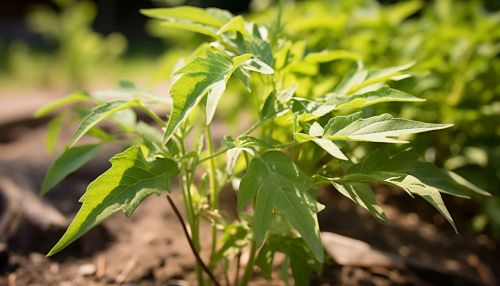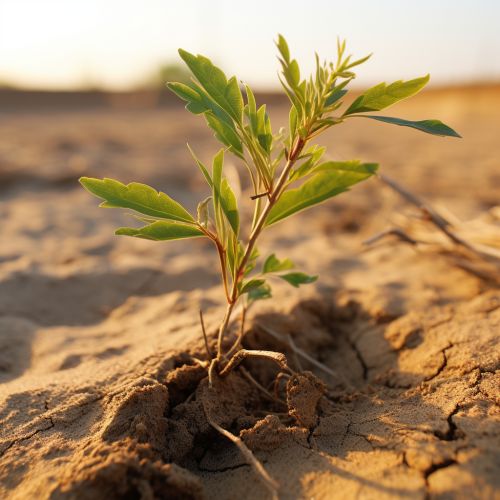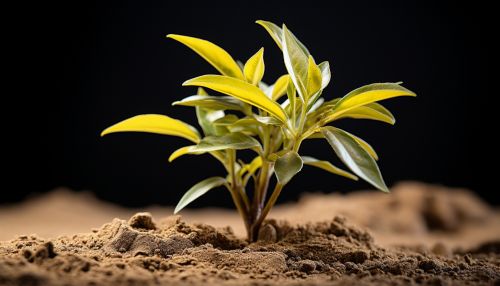Abiotic stress in plants
Introduction
Abiotic stress refers to the negative impact of non-living factors on the organisms in a specific environment. In the context of plants, abiotic stress could be caused by various environmental factors such as temperature extremes, drought, flood, wind, soil salinity, nutrient deficiency, toxic compounds and radiation More on Abiotic Stress. These stresses can alter the plant's growth and development, affecting its productivity and survival.
Types of Abiotic Stress in Plants
Abiotic stress in plants can be broadly classified into several types based on the nature of the environmental factor causing the stress.
Temperature Stress
Temperature stress can be of two types - heat stress and cold stress.
- Heat stress: It occurs when plants are exposed to high temperature conditions which are beyond their optimal temperature range More on Heat Stress in Plants. This can lead to damage in cellular structures and processes, and can even result in the death of the plant.


- Cold stress: It is experienced by plants when exposed to low temperature conditions, including frost and freezing conditions More on Cold Stress in Plants. Cold stress can lead to a reduction in photosynthetic efficiency, damage to cell membranes, and disruption of nutrient uptake.
Water Stress
Water stress in plants can be due to either excess water (flooding) or lack of water (drought).
- Drought stress: It is one of the most common and severe forms of abiotic stress, affecting plant growth and productivity worldwide More on Drought Stress in Plants. Drought stress can lead to wilting, leaf drop, and reduced photosynthesis, ultimately leading to reduced crop yields.
- Flooding stress: It occurs when plants are exposed to excess water, leading to oxygen deficiency in the root environment More on Flooding Stress in Plants. This can result in root damage, reduced nutrient uptake, and eventual death of the plant.
Salinity Stress
Salinity stress is caused by high concentrations of salts in the soil, which can affect plant growth and development More on Salinity Stress in Plants. High salinity can lead to osmotic stress, ion toxicity, and nutrient imbalance in plants.


Chemical Stress
Chemical stress in plants can be caused by various factors such as nutrient deficiency, toxicity of heavy metals, and exposure to pollutants or toxic compounds More on Chemical Stress in Plants.
Radiation Stress
Radiation stress is caused by exposure to high levels of harmful radiation, such as ultraviolet (UV) radiation More on Radiation Stress in Plants. This can lead to DNA damage, oxidative stress, and impairment of photosynthesis.
Plant Responses to Abiotic Stress
Plants have developed a range of responses to cope with abiotic stress conditions. These responses can be physiological, biochemical, or molecular in nature.
Physiological Responses
Physiological responses to abiotic stress involve changes in the plant's physical and functional attributes. These may include alterations in growth rate, leaf orientation, root architecture, stomatal conductance, and photosynthetic efficiency More on Physiological Responses to Abiotic Stress.
Biochemical Responses
Biochemical responses involve changes in the plant's metabolic processes. These may include the production of stress proteins, antioxidants, osmolytes, and secondary metabolites that help the plant cope with the stress conditions More on Biochemical Responses to Abiotic Stress.
Molecular Responses
Molecular responses involve changes at the genetic and molecular level. These may include the activation of stress-related genes, production of stress-responsive proteins, and alterations in gene expression patterns More on Molecular Responses to Abiotic Stress.
Abiotic Stress Tolerance in Plants
Plants have evolved various mechanisms to tolerate abiotic stress conditions. These mechanisms can be inherent (genetic) or can be induced by the stress conditions.
Inherent Tolerance
Inherent tolerance, also known as innate or natural tolerance, is the plant's genetic ability to withstand abiotic stress conditions More on Inherent Tolerance to Abiotic Stress. This can be due to the presence of stress-tolerant genes or due to the plant's ability to produce certain stress-responsive compounds.
Induced Tolerance
Induced tolerance is the plant's ability to enhance its stress tolerance in response to exposure to stress conditions More on Induced Tolerance to Abiotic Stress. This can involve the activation of stress-related genes, production of stress proteins, and alterations in metabolic processes.
Improving Abiotic Stress Tolerance in Plants
Various strategies can be employed to improve abiotic stress tolerance in plants. These can be broadly classified into conventional breeding methods and modern biotechnological approaches.
Conventional Breeding
Conventional breeding involves the selection and breeding of plants with desirable traits, such as stress tolerance More on Conventional Breeding for Stress Tolerance. This can be achieved through methods such as hybridization, mutation breeding, and selection breeding.
Biotechnological Approaches
Biotechnological approaches involve the use of modern biotechnology tools to improve stress tolerance in plants. These may include genetic engineering, marker-assisted selection, and genomic selection More on Biotechnological Approaches to Stress Tolerance.
